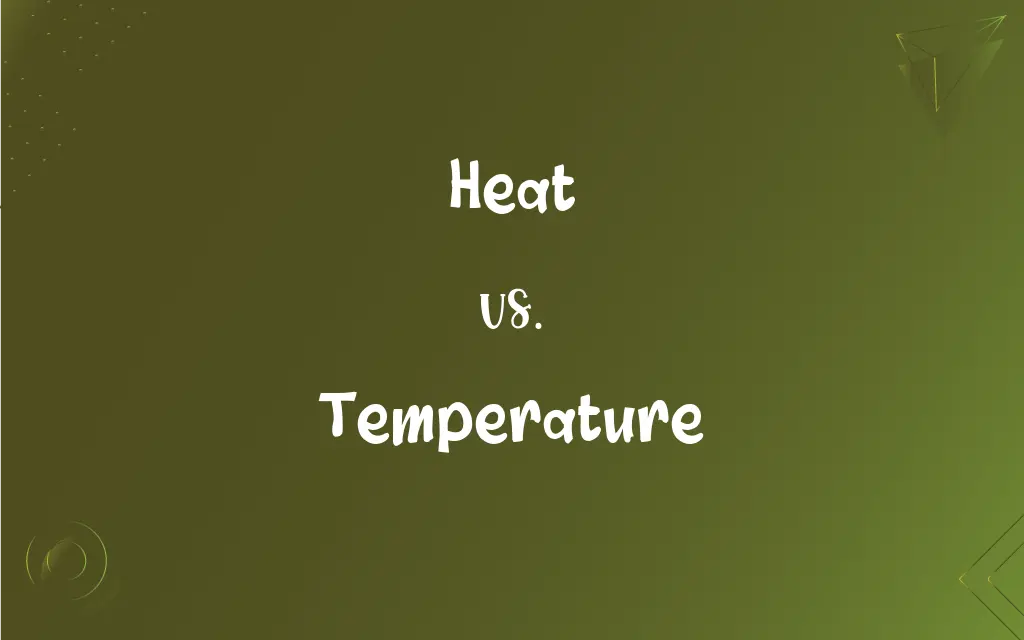Heat vs. Temperature: What's the Difference?
Edited by Aimie Carlson || By Harlon Moss || Updated on October 11, 2023
Heat is energy transferring due to temperature difference, while temperature is a measure of the average kinetic energy of particles.

Key Differences
Heat encompasses the vibrant, energetic dance of particle motion, flowing insatiably from regions of higher to lower temperature. This movement of energy is unidirectional, staunchly adhering to its intrinsic drive to seek equilibrium, thereby illuminating heat as a process, a journey of energy migration between bodies or systems. Temperature, although intimately interwoven with this energetic expedition, stands as a mere observer, a numerical descriptor quantifying the vigor of particle motion within a system, unmoved by the energy flow itself.
Elaborating further, temperature acts as the thermal yardstick, calibrating the kinetic excitement of particles in a given system or body. It does not traverse between entities but rather remains a localized, inherent characteristic. It is devoid of journey or motion, epitomizing the average kinetic energy of particles in a system without embodying a physical entity. Conversely, heat embodies the transient energy, embarking on a ceaseless quest to equalize temperature disparities, perpetuating its flow until equilibrium envelops the interacting systems.
In a more physical sense, heat can be perceived as the palpable warmth or cold transferred between bodies, manifested through various forms like convection, conduction, or radiation. Its essence thrives in its transient nature, adopting the role of an energetic courier, migrating through, or between mediums. Whereas, temperature lacks this tangible transference, establishing itself as a scalar physical quantity that necessitates no medium or pathway to assert its presence, yet determining the direction of heat transfer with its relative magnitude.
However, both heat and temperature, in their distinct roles, coalesce to orchestrate the symphony of thermal interactions in our universe. Temperature lays down the energetic landscape, presenting a playground where heat maneuvers, invariably gliding from regions of high to low temperature. These two concepts, although disparate in their physical implications, intertwine seamlessly, propelling the endless dance of thermal energy throughout the cosmos.
In scientific endeavors, the demarcation between heat and temperature becomes particularly poignant. The uniform, systematic movements of heat play pivotal roles in phenomena such as thermodynamics, while temperature acts as a key parameter in equations and laws, allowing scientists to predict heat movement. Thus, understanding the interplay and distinctiveness between heat and temperature becomes imperative in accurately deciphering and navigating the thermal phenomena of our universe.
ADVERTISEMENT
Comparison Chart
Definition
Energy in transit due to temperature difference.
Measure of the average kinetic energy of particles.
Measurement Unit
Joules (J)
Celsius (C), Kelvin (K), Fahrenheit (F)
Nature
Transferable energy.
Scalar physical quantity.
Dependency
Dependent on mass, specific heat, and temperature change.
Independent of the quantity of substance.
Physical Perception
Can be felt as warm or cold during transfer.
Perceived but not physically felt as transfer.
ADVERTISEMENT
Heat and Temperature Definitions
Heat
Heat is the energy transferred due to a temperature difference.
During winter, heat from the fireplace spreads through the room.
Temperature
Temperature is a scalar quantity that indicates the hotness or coldness of an object.
The temperature of the coffee was perfect for sipping.
Heat
Heat seeks to move from an area of higher temperature to lower temperature.
Heat from the warm ocean water is transferred to the cooler air above.
Temperature
Temperature reflects the average kinetic energy of particles within a substance.
The temperature of the gas increased as the particles moved more rapidly.
Heat
Heat can alter a body’s temperature and phase.
The heat from the stove turned the solid ice into liquid water.
Temperature
Temperature can affect the physical states of matter, influencing transitions such as melting or boiling.
At a temperature of 100 degrees Celsius, water boils and becomes steam.
Heat
Heat can manifest through various modes like conduction, convection, and radiation.
The heat from the sun reaches Earth mainly through radiation.
Temperature
Temperature can be measured using various scales, such as Celsius, Fahrenheit, and Kelvin.
The temperature of the freezer is set to -18 degrees Celsius.
Heat
Heat can be measured and calculated using specific heat capacity.
The heat absorbed by the water was calculated using its specific heat capacity.
Temperature
Temperature determines the direction of heat transfer between two bodies.
The temperature difference between the iron and the cloth ensures heat moves from the iron to the cloth.
Heat
A form of energy associated with the kinetic energy of atoms or molecules and capable of being transmitted through solid and fluid media by conduction, through fluid media by convection, and through empty space by radiation.
Temperature
The degree of hotness or coldness of a body or environment.
FAQs
How is temperature defined?
Temperature is a measure indicating the average kinetic energy of particles in a substance, representing its hotness or coldness.
What is heat?
Heat is energy that transfers between substances or systems due to a temperature difference.
Can heat be measured?
Yes, heat is measured in units of energy, typically joules or calories.
What are the common units for measuring temperature?
Common units include Celsius (C), Fahrenheit (F), and Kelvin (K).
Can objects have negative heat?
No, heat cannot be negative as it's energy transfer, but temperatures can be negative in certain scales (e.g., Celsius, Fahrenheit).
Can temperature affect reaction rates?
Yes, temperature often influences the rate at which chemical reactions occur.
How is heat generated?
Heat can be generated through various means, like friction, chemical reactions, and electrical resistance.
What role does temperature play in phase changes?
Temperature determines the conditions at which substances change phase, such as from solid to liquid (melting).
Is it possible to have a system with no temperature?
Theoretically, a system at absolute zero would have no thermal motion, but achieving this is practically impossible.
Can heat be converted to other forms of energy?
Yes, heat can be converted into other energy forms, like mechanical or electrical energy.
Is absolute zero a reachable temperature?
Absolute zero (0K) is theoretically defined but cannot be physically reached.
Does heat always transfer from hot to cold?
Yes, heat naturally flows from areas of higher temperature to areas of lower temperature.
What instrument is used to measure temperature?
A thermometer is commonly used to measure temperature.
How are heat and temperature related?
Heat transfer is driven by a temperature difference, moving from a higher to a lower temperature region.
Can heat transfer occur in a vacuum?
Yes, heat can transfer through radiation in a vacuum.
Can heat be transferred without affecting temperature?
Yes, during phase changes (like melting), heat transfer doesn't change the temperature of a substance.
Is temperature a form of energy?
No, temperature is not energy but a measure related to the average kinetic energy of particles.
How does temperature affect matter?
Temperature can influence the phase, density, and other physical properties of matter.
Does heat have a direction of flow?
Yes, heat flows from a region of higher temperature to a region of lower temperature.
What happens to the temperature during a phase change?
Temperature remains constant during a phase change, as heat energy is used to change the substance’s phase, not its temperature.
About Author
Written by
Harlon MossHarlon is a seasoned quality moderator and accomplished content writer for Difference Wiki. An alumnus of the prestigious University of California, he earned his degree in Computer Science. Leveraging his academic background, Harlon brings a meticulous and informed perspective to his work, ensuring content accuracy and excellence.
Edited by
Aimie CarlsonAimie Carlson, holding a master's degree in English literature, is a fervent English language enthusiast. She lends her writing talents to Difference Wiki, a prominent website that specializes in comparisons, offering readers insightful analyses that both captivate and inform.































































